Saturday, August 31, 2019
Friday, August 30, 2019
Places To Visit In Khajuraho, Khajuraho Tour Planner - Rajasthan Tour Planner
5:23 AM
No comments
The Khajuraho Group of Monuments is a group
of Hindu, Buddhist and Jain temples in Madhya Pradesh, India, about 175
kilometres (109 mi) southeast of Jhansi. They are one of the UNESCO World
Heritage Sites in India. The temples are famous for their nagara-style
architectural symbolism and their erotic sculptures.

Most Khajuraho temples were built between 950
and 1050 by the Chandela Rajput dynasty. Historical records note that the
Khajuraho temple site had 85 temples by the 12th century, spread over 20 square
kilometers Of these, only about 25 temples have survived, spread over 6 square
kilometers. Of the various surviving temples, the Kandariya Mahadeva Temple is
decorated with a profusion of sculptures with intricate details, symbolism and
expressiveness of ancient Indian art.
The Khajuraho group of temples were built
together but were dedicated to two religions, Hinduism and Jainism, suggesting
a tradition of acceptance and respect for diverse religious views among Hindus
and Jains in the region.
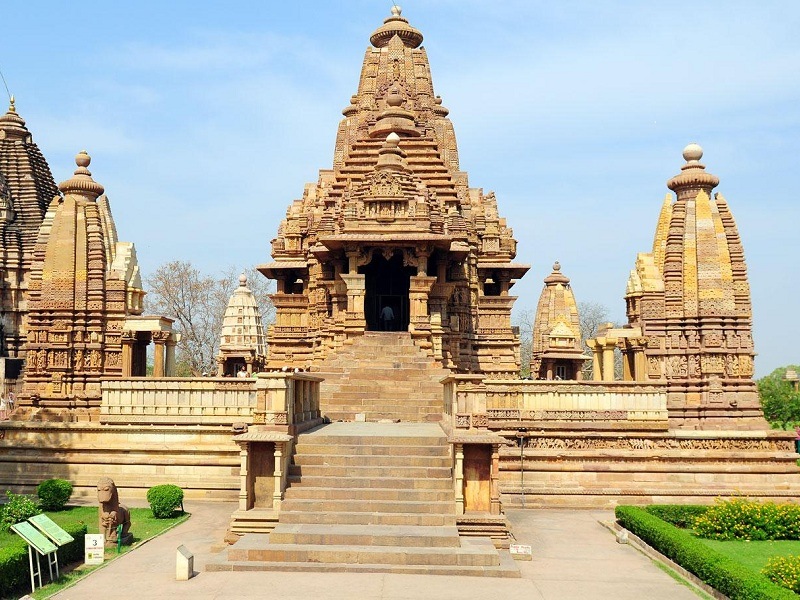
The Hindu and Jain temple complex at
Khajuraho in central India has become a major tourist site for Indians and
International tourist. Built nearly a thousand years ago, but abandoned two
centuries later, Khajuraho remained a minor pilgrimage site into the present
century. The Khajuraho temples include thousands of sexual relief carvings,
much publicized throughout India. Khajuraho temples were built during the
Chandela period, a dynasty which survived for five centuries before falling to
the onslaught of Islam. The history tells us that in the ancient India, the
kings did not sponsor directly the making of rock-cut caves, stupas or temples.
None of the stupas have sculptures of the Kings and rulers of those times. But
with the arrival of the medieval period, rulers began to patronize personally
the making of temples.
.jpg.jpg?1536216782)
The personal attention of the ruler led to
the making of the larger temples, especially from the 10th or 11th century
onwards, under the Cholas in south India. Similarly changes were seen under the
rule of the Chandela in the central India. Chandela dynasty was well
established and there was peace and prosperity in 10th and 11th century. Art
and culture flourished there as the kings were great patrons of poetry and
theatre. The symbol of their cultural achievements was at their capital city of
Khajuraho, where between the 10th and 12th centuries, one of the most splendid
temple cities in the history of the world was created. There were originally 85
temples were created out of which only 22 are remain today. The first king who
started construction in Khajuraho was Harsh who built the 64 Yogini Temples.
The most notable prince of this dynasty was King Dhanga whose time is known for
building the most beautiful Khajuraho Temples of Parsvanath and Vishwavanath.
His grandson Vidyadhara built the Kandariya Mahadev Temple. This was the golden
era of central India. Most of the Khajuraho Temples at Khajuraho were
constructed between 950 AD and 1050 AD and are either Hindu or Jain.
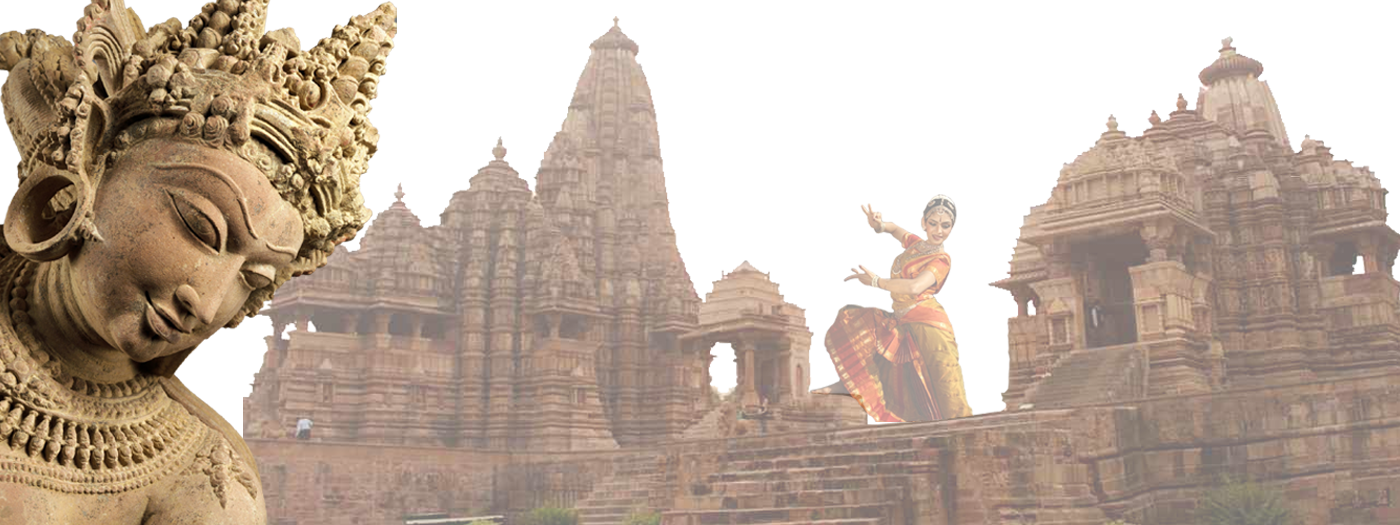
The Kandariya Mahadeva temple built in the
early 11th century and dedicated to Shiva. The Lakhmana temple was built in 954
AD by King Dhanga to celebrate independence from the Gurjara Pratihara rulers.
The Lakhmana Temple was dedicated to Vishnu. By the time of Chandela, the
Indian temples form had fully developed. The objective of the temple was that a
devotee comes to it with the aspiration of the self transcendence and to
receive the grace of the deity in the garbha griha. The devotees came to the
temple to awaken within themselves and to realize the whole creation of the
world is the manifestation of the deity in the garbha griha. Some believe that
the erotic art suggest the sexual practices. Its noted that only ten percent of
the carvings contain errotic themes and rest of the sculptures depict the
everyday life of the common persons such as women putting on makeup, playing
games, dancing, knotting and unknotting their girdles, and other themes such as
musicians, potters, farmers etc. On the temple walls, one can see Siva, Vishnu,
Brahma, Indira, Agni and their spouses.
The Kandariya Mahadeva
Temple, meaning "the Great God of the Cave", is the largest and most
ornate Hindu temple in the medieval temple group found at Khajuraho in Madhya
Pradesh, India. It is considered one of the best examples of temples preserved
from the medieval period in India.
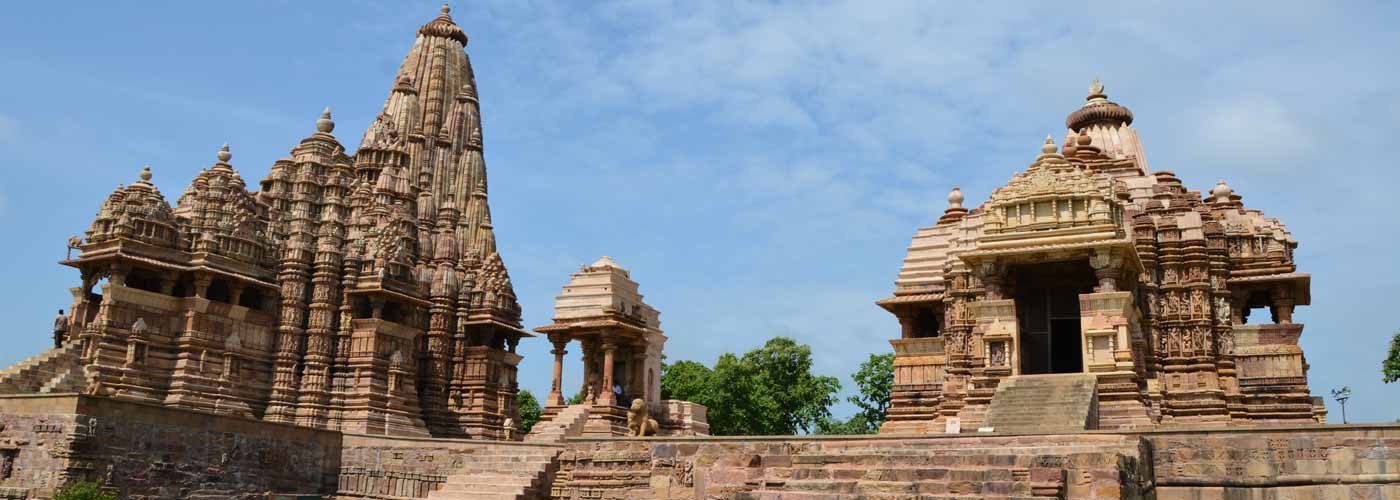
Chausath Yogini temple –
The Chausath Yogini temple is a ruined Devi temple in the Khajuraho town of Madhya Pradesh, India. Dated to the late 9th century, it is the oldest surviving temple at Khajuraho. Unlike the Chausath Yogini temples at other places, it has a rectangular plan.
The Chausath Yogini temple is a ruined Devi temple in the Khajuraho town of Madhya Pradesh, India. Dated to the late 9th century, it is the oldest surviving temple at Khajuraho. Unlike the Chausath Yogini temples at other places, it has a rectangular plan.
Lakshmi temple is dedicated
to Goddess Lakshmi, consort of Lord Vishnu. This structure is one of the
monument among Khajuraho Group of Monuments, a World Heritage Site in India

The Vishvanatha Temple is a
Hindu temple in Madhya Pradesh, India. It is located among the western group of
Khajuraho Monuments, a UNESCO World Heritage site. The temple is dedicated to
Shiva, who is also known as "Vishvanatha", meaning "Lord of the
Universe".

Thursday, August 29, 2019
Things To Do in Jaisalmer - Most Visit Tourist places Suggest By Rajasthan Tour Planner
1:44 AM
No comments
Golden Fort Jaisalmer :-
At a distance of 1.5 km from Jaisalmer Railway Station, Jaisalmer Fort locally known as Sonar Quila (Golden Fort) is located in the heart of Jaisalmer city. It is one of the largest forts in the world and also one of the top places to visit in Jaisalmer. Jaisalmer Fort. is a World Heritage Site declared by UNESCO under the group Hill Forts of Rajasthan.
Jaisalmer Fort was built atop the Trikuta Hill in 1156 AD by the Bhati Rajput ruler Maharawal Jaisal Singh, from where it originates its name. It was the center of a number of historical encounters between the Bhattis, Mughals, and Rathores of Jodhpur. The Fort of Jaisalmer survived several attacks by the Muslim rulers like Aladdin Khilji and Mughal Emperor Humayun. The city also served as a refuge and way-station for caravans and travelers along the Silk Road.
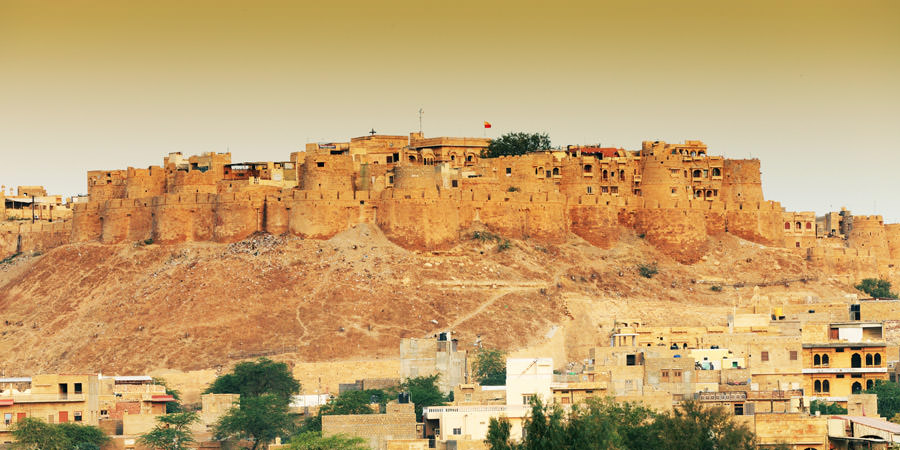
Standing proudly in the middle of the great Thar Desert, this fort is regarded as 'The Pride of Jaisalmer'. Its massive yellow sandstone walls are a tawny lion color during the day, fading to honey-gold as the sun sets, thereby hiding the fort in the yellow desert. For this reason, it is also known as the Sonar Quila or Golden Fort.
The Jaisalmer Fort architecture is awe inspiring and marvelous. The seamless blend of Rajput and Islamic styles, the golden tinge due to the yellow sandstone, and the enthralling carvings & sculptures make it rank among the glorious forts in Rajasthan. It is 1,500 ft long and 750 ft wide and is built on a 250 ft high hill. The basement of the fort has a 15 ft tall wall forming a double line of defense. The fort is protected by a 30 ft tall wall surrounding it on all sides. This fort comprises of 99 bastions providing crucial protection to the fort during attacks.
Inside the fort complex, tourists can find several architectural buildings which include palaces, houses and temples. Jaisalmer fort has narrow winding pathways which interlock several parts of the fort. The complex of Jaisalmer fort is so expansive that almost one-quarter of the town's population located inside the fort itself. There are numerous wells inside the fort that are a regular source of water for residents.
:max_bytes(150000):strip_icc()/GettyImages-533638374-5b9ced74c9e77c0050b73539.jpg)
The fort has four entrances namely Ganesh Pol, Rang Pol, Bhoota Pol and Hawa Pol. The main attraction of the fort is Maharawal Palace popular for its marble throne. The Palace also has a wonderful museum which showcasing arms, dresses, utensils, & ornaments of the Rajput kingdom. An added attraction of this place is a five-storied Tazia tower located parallel to the Maharawal Palace. This tower was constructed by Muslim craftsmen and is made with decorative Bengali styled roofs. Jain Temple and Lakshmi Temple are also quite famous among the visitors.
Palace Timings: 9 AM to 6 PM
Palace Entry Fee: Rs. 50 for Indians, Rs. 250 for Foreigners, Rs. 50 for Camera
Patwon ki Haveli Jaisalmer :- At a distance of 500 m from Jaisalmer Fort and 1.5 km from Jaisalmer Railway Station, Patwon-ki-Haveli is situated in a narrow lane near the Patwa Complex in Jaisalmer. It is the first haveli to have been erected in Jaisalmer and also one of the top places to visit in Jasalmer.
The Patwon ki Haveli is considered to be the one of the largest as well as the finest haveli of Rajasthan. This haveli is essentially a cluster of five havelis, which was constructed in 1805 CE by Guman Chand Patwa. A rich trader, Guman Chand Patwa constructed five separate sections for his five sons. The first haveli is the main and also the grandest haveli in the complex. The entire construction took over 55 years to complete.

Located in the center of the city, it is truly an outstanding piece of architecture. It is renowned for its ornate wall paintings, intricate yellow sandstone-carved jharokas or balconies, gateways and doorways. The haveli is built using yellow sandstone and the main gateway is brown in colour. The haveli is five stories high divided into six apartments. The walls also feature beautiful mirror work and several paintings. There is a stunning apartment which is flawlessly painted with beautiful murals. There are about 60 balconies in the haveli.
Amongst the five Havelis which form the entire complex, one has been converted into a museum which displays a vast collection of antique furniture and decorative goods. Besides this, the third Haveli or mansion in the premises also houses rich items that include traditional art and craft work of the local craftsmen. Two havelis are under the authorization of the Archaeological Survey of India and one serves as private accommodation.
Currently, this haveli is maintained by the state government, which uses it for different official purposes. The office of State art and craft department and the Archeological Survey of India (ASI) is placed in the haveli.
Timings: 8 AM to 6 PM
Entry Fee: Rs. 20 for Indians, Rs. 100 for Foreigners and Rs. 50 for Camera
Jaisalmer War Museum :- At a distance of 11 km from Jaisalmer Railway Station and 12 km from Jaisalmer Fort, Jaisalmer War Museum is situated at Military Station on the Jaisalmer - Jodhpur Highway. This unique war museum is surely a must visit place for all Indian and foreigner tourists coming to Jaisalmer.
Jaisalmer War Museum was set up by the Indian Army in 2015 and was inaugurated on 24th August by Lieutenant General Ashok Singh, General Officer Commanding in Chief, Southern Command. The inauguration of the Museum in the Golden Jubilee Commemoration Year of 1965 Indo Pak War is also a tribute to all soldiers who made the supreme sacrifice.
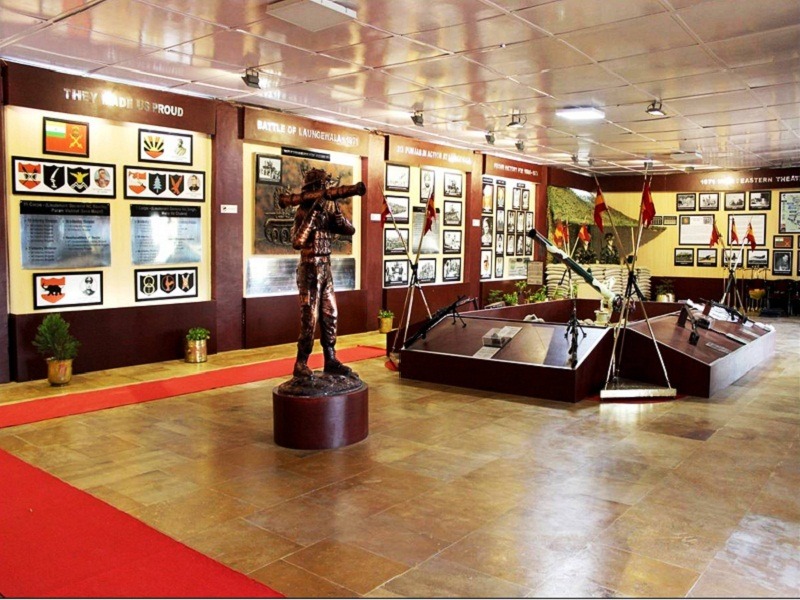
The museum covers an area of over 10 acres of land. It has two large Information Display Halls, an Audio Visual Room and a souvenir shop. Apart from the evolution of the Indian Army, the museum showcases tales of bravery and sacrifice of heroes of the wars. War trophies and vintage equipment are on display along with tanks, guns and military vehicles. The museum has murals of soldiers who lost their lives in the war and weapons used at that time. The Indian Air Force has also contributed in the museum by presenting a hunter aircraft, which was used during the Battle for Longewala during the 1971 Indo Pak War.
The Museum is organized by the Indian Army. The entry to the Jaisalmer War Museum is open to and free for all visitors.
Timings: 10 AM to 6 PM
Tanot Mata Temple Jaisalmer :- The Tanot Mata Temple situated in the Tanot village of district Jaisalmer, is a major attraction for those visiting the Thar Desert in Rajasthan. It is enveloped within numerous legends that are sure to instil awe and curiosity towards its sacred power and purity. The heritage site is preserved and maintained by the Border Security Force (BSF) of India since the Indo-Pakistan war in 1971.
Localities have immense faith on the temple’s austerity and pay regular visit to the Tanot Mata. She is believed to be an apparition of the Hinglaj Mata Goddess. Tanot is in close proximity with Longewala, a critical India-Pakistan border that forbids access to any individual without permission of Indian Government authorities. Due to its topography, it can harness large quantities of wind energy, thus visitors can see the rows of windmill energy power plants established here. There is a museum built adjacent to the temple that displays certain historic artefacts collected from the war period. This is a must visit place for those who wish to pay their homage to the Indian Army and the temple that is considered holy by the Indian heroes of defence and harmony.

History :- It is said that during the Indo-Pakistani War of 1965, Pakistani Army dropped over 3000 bombs targeting the temple but not even one exploded! The Pakistani Tank regiment was stupefied and kept shelling but not one bomb exploded. After the war the Pakistani General actually asked his counterpart in India about this incident and on knowing the story of the power of the temple that apparently protected the area he asked to see this place. This request was granted and the Pakistani General actually went to the temple and paid his respects and acknowledged the supernatural happening. After the war the temple management was handed over to Border Security Force of India on their request and to date the temple is maintained and manned by the BSF soldiers.
After paying your respects to the Goddess, you can take a round of the museum established in the same vicinity. It holds a public exhibition of the arms and ammunitions used during the Indo-Pakistan wars of 1965 and 1971. They hold great significance, as the bombs used to attack the natives of Tanot village never diffused. The place is one of the best place to explore in the Thar Desert in Rajasthan. This temple was shown in the film Border. The best time to visit is November – January, when the temperature is not likely to be extremely high. Taxis can be hired from Jaisalmer After completing this pilgrimage trip, you can plan a camel safari in the Thar Desert or plan a sightseeing trip of the majestic forts of Jaisalmer.
Longewala Border :- Longewala is a border town in Thar desert near Jaisalmer, Rajasthan. The army of Lt. Kuldip Singh was commanding this small post because on the other side Pakistani forces were awaiting an opportunity to attack and takeover Jaisalmer. At the night of 4th December 1971, the Indian army observed noises across the border that suggested a heavy platoon approach. As it was dark, the moon was the only source of light that lit the scene.

The Battle - When sources confirmed that Pakistan indeed was approaching, Lt. Kuldeep Singh contacted the headquarters and asked for reinforcements. He was informed that it would take six hours for backup to be available and was advised to retreat to a nearby town, Ramgarh. But Kuldeep Singh and his men held ground fearlessly and decided to fight. After midnight Pakistan surfaced near Longewala and opened fire with artillery guns. As the 45 heavily equipped tanks of Pakistan approached the border, Indian defences laid a hasty anti-tank minefield. Indians were at the advantage of holding the higher ground; Pakistani tanks struggled to move upward and blasted themselves in doing so. This gave an opportunity to Indian soldiers to spot and attack the enemy, a fire lit the otherwise dark battlefield. Indian defence used a smoke screen to confuse the Pakistani soldiers and stalled the battle till reinforcements arrived.

Who won the battle?
India, though outnumbered, applied clever strategies to maneuver its way through the fight. After a long battle, Indian Air force was able to send backup in the morning. Now, the opposition’s battalion was an easy target as they were on the ground and didn’t have an Airforce to help them out. After getting 22 tanks blasted with rockets, Pakistani army was forced to withdraw.
Aftermath of the battle - 120 soldiers against 2000, sounds daunting. But what’s surprising is that India only lost 2 soldiers and 1 tank while Pakistan lost 200 soldiers and 36 tanks, in the battle. Kuldeep Singh was applauded for his strategic win and was conferred with the Mahavir Chakra for showing great courage.
Longewala hosted a fray that speaks of sheer fearlessness and heroism of Indian soldiers. It’s a perfect example of how a fight can be smoothly won if you club your fires with a little strategy. The valor displayed by Kuldeep Singh and his men is now dictated to the army, to build their mettle and to inspirit them with enthusiasm. This battle was one of a kind and deservingly fixed a spot in Indian history.
Kuldhara village – Haunted Village Sam Road jaisalmer - Kuldhara Village, located within 20 kilometres from the Golden City Jaisalmer is not always a known name among the tourists, but a little research will show how this is one of the most interesting and intriguing attraction sites that you should absolutely include in your itinerary. The village, rich with its fair share of legends and myths, is said to be a spooky and haunted village. The abandoned and eerily beautiful appearance of it, standing solitary amidst the vast stretches of desert, lives up to its reputation. There have been stories of ghostly and paranormal activities in and around the village, but like always no one could provide any solid proof of it. Nevertheless, Kuldhara village is an exciting place to visit just for its architectural beauty and the vibe of history.
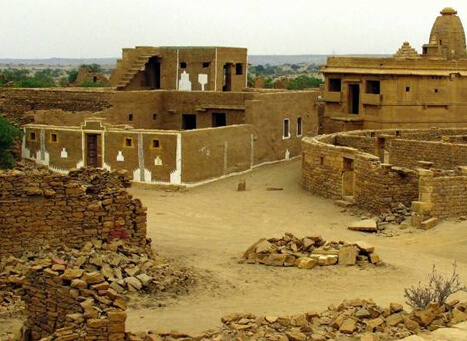
Once you visit the place, the sheer blankness of the village so massive, yet so eerily silent and abandoned with just the houses standing like skeletal corpses of the past engulfs you entirely. Adds to that the legend how the residents of the entire area left the place overnight altogether to save their honors and lives from the hands of the tyrannical minister who ruled over the place, and you have got the perfect setting for a bestselling horror story.
There is nothing to do as such, but the experience itself makes up for all of it. The government with the help of some private construction companies are setting up cafes, restaurants and even lodges for the night stay to turn the place into a full-fledged tourist place. The constructions are undergoing as of December 2017 and once finished, Rajasthan hopes to attract more people to visit and experience the great beauty amidst the barrenness.
Bada Bagh jaisalmer :- At a distance of 8 km from Jaisalmer Railway Station and 7 km from Jaisalmer Fort, Bada Bagh or Bara Bagh is a historical garden located on Ramgarh road and halfway between Jaisalmer and Lodurva in Rajasthan.
Bada Bagh means big garden. It is a garden of cenotaphs or chhatris of the royal family of Jaisalmer. A descendant of Maharawal Jaisal Singh, Jait Singh II, commissioned a dam to create a water tank in the 16th century AD. This made the desert green in this area. After his death, Bada Bagh was fully developed by his son Lunakaran.
The garden stands at the foot of a hill and several chhatris or cenotaphs stand in memory of the late rulers of Jaisalmer. Cenotaphs are also known as chhatris and one cenotaph is erected for each ruler. The cenotaph of Maharawal Jait Singh is the oldest of all. Many cenotaphs were built by subsequent rulers for the Bhatti royal family of Jaisalmer. This continued till the 20th century when the last one for Maharawal Jawahar Singh was left incomplete as his son who ascended the throne after him, died within one year of his ascension. This was considered to be bad luck and from then on, the tradition of cenotaphs at Bada Bagh was discontinued.
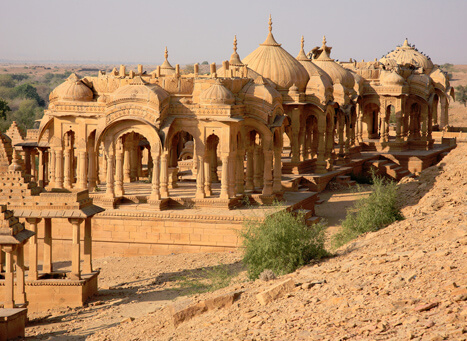
The architecture of these chhatris is a blend of Paliwal, Mughal, and Rajput styles of architecture. Each cenotaph contains inscribed tablets with names of the King and Queen. Some of the cenotaphs have a statue of the King on a horse along with his queen standing nearby. The size of the chhatri varies according to the status of the person.
This garden also includes a tank and a dam, along with a Govardhan Stambh (pillar). The pillar was constructed for commemorating the construction of the nearby tank and dam. Locals refer to the dam as Jait Bandh, while the tank is known as Jait Sar. The Jait Bandh is a huge structure measuring over 1,200 feet in length and 350 feet in width. Both the tank and dam has been constructed using solid blocks of stone.
Timings: 8 AM to 6 PM
Entry Fee: Rs. 20 for Indians and Rs. 50 for Foreigners
Gadisar lake Jaisalmer :- At a distance of 1.5 km from Jaisalmer Railway Station and 1.5 km from Jaisalmer Fort, Gadisar Lake or Gadsisar Lake is an artificial reservoir in Jaisalmer. It was the only source of water for the Jaisalmer city in the olden days and also one of the best Jaisalmer sightseeing places.
The Gadisar Lake was constructed by Raja Rawal Jaisal, the first ruler of Jaisalmer and later reconstructed by Maharawal Gadsi Singh in the year 1367 AD. It is said this rain water lake once provided water to the entire town. At present Gadisar Lake gets water from Indira Gandhi Canal so it never dries.
Located towards the south of Jaisalmer city, the entrance to the Gadisar Lake is through a magnificent and artistically carved yellow sandstone archway that is known as the Tilon-Ki-Pol. There are numerous shrines and small temples on the embankment of this lake. The most popular among these temples is the Krishna Temple which houses a statue of Lord Vishnu. There is a big domed pavilion in the center of the lake. The main attractions of the lake are the different species of birds, which migrate from distinct places.
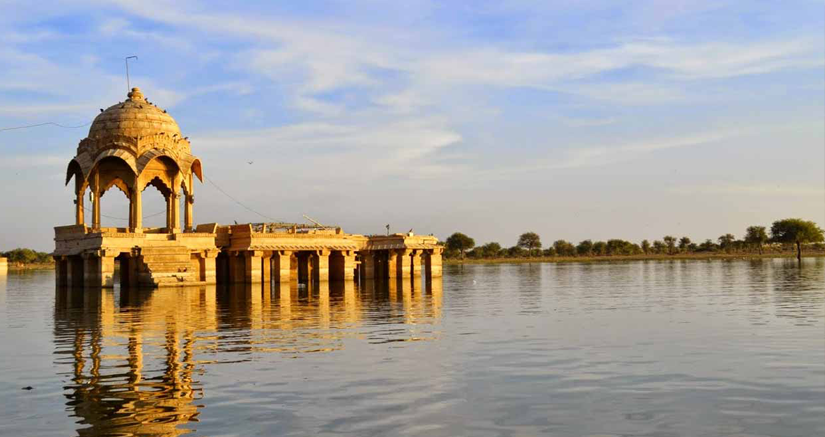
The Gadisar Lake can be visited any time of the day, though it is best to go early in the morning and watch the sun rise. Boating facility is also available in this lake where charges vary from type of boat and based on duration of boating. Shikaras are also available to go around the lake. The serene Gadisar Lake springs to life during the annual Gangaur celebrations. This is the most popular point to take photographs of Jaisalmer Fort early in the morning when the fort looks golden with the first rays of the Sun and also a bird viewing site and a major attraction of Jaisalmer city.
Timings: 6 AM to 6 PM
Sam Sand Dunes Jaisalmer :- At a distance of 40 km from Jaisalmer, Sam Sand Dunes are situated at the edge of Jaisalmer Desert National Park in Rajasthan. Lies in the midst of the Thar Desert, these sand dunes are amongst the most popular places to experience Rajasthan Tourism and also one of the prime places of Jaisalmer Tourism.
Sam has a truly magnificent stretch of sweeping dunes, with sparse or no vegetation. The 3 km long, and 1 km wide sand dunes reflect the true image of Rajasthan. Undeniably one of the most picturesque spots in the desert, the Sam Sand Dunes have gained tremendous tourist reputation over the time. The unrelieved ocean of sand constantly changes its appearance at every gentle gush of wind. The whirling air currents of this area match with those of the sandstorms in the Sahara. This time many Desert camp In sam sand dunes But Garh Rajputana camps is luxury Desert camp in Jaisalmer , Camp offer Camel Safari, there are many other Adventure activities like jeep safari, Paragliding, Quad Bike safari and desert camping at Sam Sand Dunes. Night stay with Swiss tents and mud cottages next to dunes. Adding to the magical charm of the atmosphere are the wonderful folk dance and music performance by the local artists. . . Tourists can be assured of enjoying the magic of dunes completely in the company of these guides. The dunes are best visited during the months between October and February when the heat is relatively less in the region. Evenings and night are the best times to visit the dunes because at this time the silver rays of moon spread its radiance in the entire region thereby making it glow like an ornament.

There is a Desert Festival organised in the month of February and is the best time to visit these dunes. This is a 3-day event showcasing the heritage and culture of Rajasthan. This extravaganza includes of a lot of events such as puppet shows, various competitions such as tug of war and Biggest Moustache, camel race, various folk performance and more. During this time, the desert comes alive with the sound and light show, dance and music.
Jaisalmer Attractions
Jaisalmer Tour Planner
Rajasthan Budget Tour Packages
Rajasthan Luxury Tour Packages
Tuesday, August 27, 2019
Enjoy Rajasthan Tour with Car and Driver
4:43 AM
No comments
Rajasthan is the Biggest state of India, and it is one of the most popular tourist destinations in India. This state has great tourism potential and enthralls tourists and vacationers with its awe-inspiring tourism options in the forms of culture, tradition, temples, art & architecture, history, forts & palaces, monument, havelis, wildlife sanctuaries & parks, rippling sand dunes, Thar Desert etc.
Udaipur :-Udaipur is also known as the City of Lakes. The city was the capital of the Sisodiya Rajputs of Mewar and it was founded in 1553 by the Sisodiya Rajput Ruler Maharana Udai Singh II. The Mewar Rajputs founded the city to relocate their capital from Chittor to a more secure location. Udaipur city is known for its elegant palaces, forts, and lovely lakes. It is one of the most beautiful and romantic cities in India. Key attractions of tourist interest in the city are City Palace, Jagdish Temple, Lake Palace, Pichola Lake, Fateh Prakash Palace, Monsoon Palace, Fateh Sagar Lake, Udai Sagar Lake, Eklingji Temple, Nagda Temple, etc. While in a few texts, it has been termed as the Venice of the East. Today, most of the palaces have been converted into hotels, thus attracting a huge no. of tourist crowd to this city.

Jaipur :-Jaipur is the capital of this state. Jaipur is also the largest city in the princely state of Rajasthan.It was founded in 1727, by the Kachwaha Rajput Ruler Sawai Jai Singh II, who was the ruler of Amber. Jaipur is also known by the nickname ‘Pink City of India’ which is due to the distinctive saffron or pink color of the buildings of city. The planning of the city was done according to the Vedic Vastu Shastra (Indian architecture). The well planned streets and detailed and artistic architecture make it one of the top preferred tourist locations. Worth visit attractions in Jaipur city are Amber Fort, City Palace, Albert Hall Museum, Hawa Mahal, Jantar Mantar, Jaigarh Fort, Nahargarh Fort and Heritage Hotels And much more places to visit.
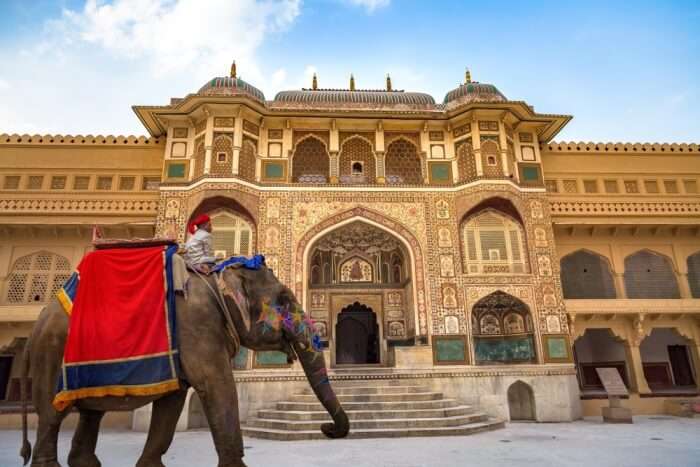
Jaisalmer : –Jaisalmer is also known as the Golden City of India The aptly named “golden city”, which comes from its view during the day, the city of Jaisalmer lies in the heart of the Thar Desert. The city was founded by The Bhati Rajput ruler Maharawal Jaisal Singh in 1156 Ad. The city gets its name from the golden sands of the Thar Desert and the same golden colored sandstone used in the city’s architecture. The city is a famous tourist spot due to its magnificent architecture and the various arts and crafts which are unique to this region. The city thrives on tourism, and can be called a home away from home for a huge no. of tourists from all around the world. Key attractions of tourist interest in the city are Its Golden Fort, Jain Temples, Havelis and an exciting trip to rippling sand dunes of vast Thar Desert. The unique feature about the city of Jaisalmer is its architecture. It was built as a walled city which makes it one of the largest living forts in the world. The fort has numerous eateries that offer Italian, French and local cuisines. Visit during the months of November and December and you will enjoy this castle city to its fullest.
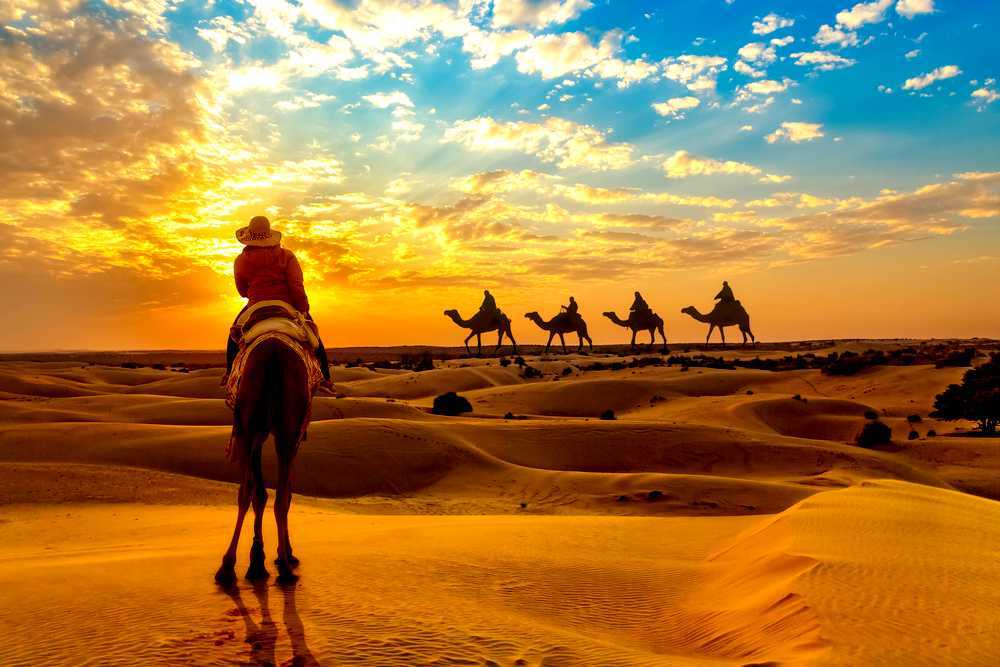
Bikaner :-Bikaner is also known as the Camel City, Bikaner is a wonderful tourist place to visit in Rajasthan. It holds a prime position in boosting tourism in Rajasthan with major attractions like Junagarh Fort, Lalgarh Palace, Havelis, and sand dunes. The city of Bikaner was founded in 1488 by the Rathore Rajput Ruler Rao Bika. Rao Bika was the son of the Rathore Ruler Rao Jodha who founded Jodhpur. The place is known for its forts and food. The various arts and crafts of this place are also unique, especially the intricately carved windowpanes called jharokhas. It is one town we would personally recommend for you to visit if you want to experience the authentic taste of rajasthani cuisines. The various fairs held in Bikaner also attract a huge no. of visitors from all around India and the world. Bikaner is a wonderful tourist place to visit in Rajasthan. It holds a prime position in boosting tourism in Rajasthan with major attractions like Junagarh Fort, Lalgarh Palace, Havelis, sand dunes And the famous temples like Karni Mata and Laxmi Nath Temple etc.

Jodhpur :-Jodhpur is also the second most populated city of Rajasthan after Jaipur. The city was founded in 1459 by the Rathore Rajput Ruler, Rao Jodha Singh of Marwar. The city was founded as Marwar’s new capital after the fall of the former capital of Mandore. Jodhpur is also called the Sun City as it enjoys a bright sunny weather all year round. Strategically, it is considered to be the most important city of western Rajasthan. Jodhpur is an important tourist destination as well. Jodhpur has been listed many a times in various tourism magazines and documentaries and has topped the lonely planet’s list of most extraordinary place to stay in 2014. Jodhpur is also known as the Blue City of India, Jodhpur is the second largest city in the state. It is a wonderful tourist place to be visited on Rajasthan travels and tours with attractions like mammoth Mehrangarh Fort, Jaswant Thada Memorial, Umaid Bhawan Palace, Mandore Gardens and many heritage hotels.

Pushkar :-Pushkar is a holy city in Rajasthan. It is one of the most sacred cities in India with lots of attractions like Lord Brahma Temple, Gayatri Temple, Savitri Temple, Pushkar Palace, Rose Gardens, Pushkar Ghats, etc. Lying in the Ajmer District of Rajasthan, the holy City of Pushkar is often described as the king of pilgrimage sites in India. The town is located at the shores of the Pushkar Lake, which was created by the tears of Lord Shiva. The town is famous for its temples and various Ghats which are frequented by hundreds of visitors during the annual bath.
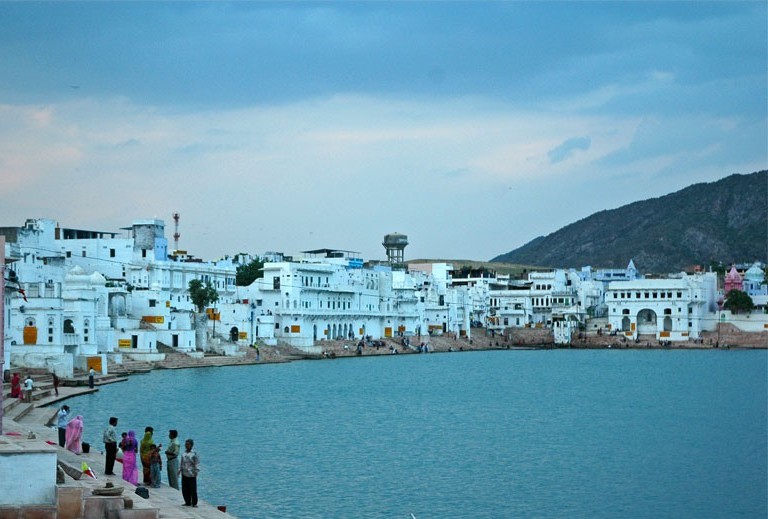
Ranthambhore :–Ranthambore is one of the most popular destinations of Rajasthan tourism. It is globally famous for Ranthambore Tiger Reserve & National Park. The key attractions of the park are tigers, Ranthambore Fort, Jogi Mahal and ancient banyan tree. The Ranthambore Fort and the Ranthambore National park Both places are the attraction of city. The Ranthambore national Park and its wild life century is the heaven for wild life photographers.
visit our website for more information about rajasthan tourism. and contact us to book a customize tour package and visit rajasthan india with us. we have the best packages .
Monday, August 26, 2019
Chittorgarh Fort || Places To Visit In Chittorgarh || Attractions of Chittorgarh
3:24 AM
No comments
Chittorgarh is one of the most enchanting cities of Rajasthan. Synonymous with bravery and romance, this city reflects the glorious history of Rajputs. It was once the seat of power in India. This land boasts of several interesting legends and tales of Rajputs.
Some of the main attractions of Chittorgarh are:
Chittorgarh Fort Chittorgarh :-
The most fabulous attraction of the city, this fort is the largest fort in India. Considered as one of the best forts of Rajasthan, it was built in the 7th century in a majestic Rajput architectural style. Beautifully set on a 180 m high hill, the fort boasts of several attractions such as Fateh Prakash Palace, Rana Kumbha Palace, Rani Padmini’s Palace and Chhhatris. A visit to this fort will take you back to the times of Rajputs.
The most fabulous attraction of the city, this fort is the largest fort in India. Considered as one of the best forts of Rajasthan, it was built in the 7th century in a majestic Rajput architectural style. Beautifully set on a 180 m high hill, the fort boasts of several attractions such as Fateh Prakash Palace, Rana Kumbha Palace, Rani Padmini’s Palace and Chhhatris. A visit to this fort will take you back to the times of Rajputs.
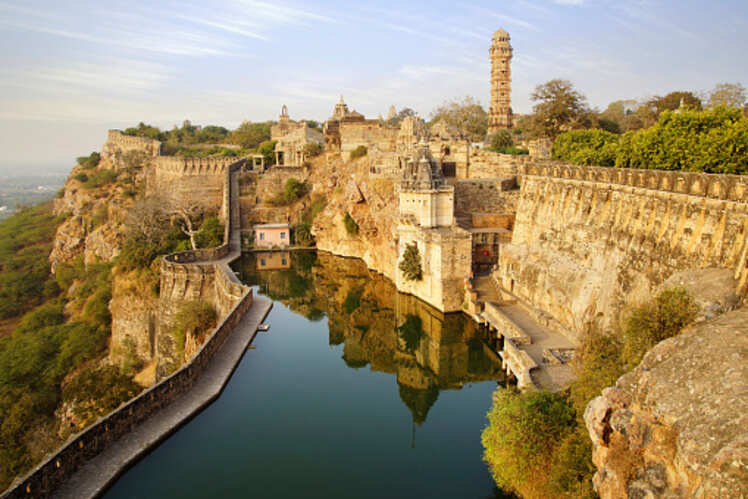
Rana Kumbha Palace Chittorgarh :-
Rana Kumbha Palace is a part of number of legends. These legends are associated with queen Padmini of Chittorgarh. The palace is also named after the greatest of the Sisodias. The location of the palace also has its association with the history of the place. It is in this location where Padmini committed Jauhar or self immolation. The self immolation was also joined by 700 followers to save honor. This was done as a way to avoid getting dishonored at the hands of the enemies. However, after much effort, archaeologists still haven’t discovered the underground cellars where this act was performed.
Rana Kumbha Palace is a part of number of legends. These legends are associated with queen Padmini of Chittorgarh. The palace is also named after the greatest of the Sisodias. The location of the palace also has its association with the history of the place. It is in this location where Padmini committed Jauhar or self immolation. The self immolation was also joined by 700 followers to save honor. This was done as a way to avoid getting dishonored at the hands of the enemies. However, after much effort, archaeologists still haven’t discovered the underground cellars where this act was performed.
On visiting the Rana Kumbha Palace, you will surely be able to come across a number of historically significant items. The palace was built by Bappa Rawal in 734 AD. He was the founder of the House of Mewar. It was later renovated by Maharana Kumbha. The palace had also played the role of residence to Princess Mira Bai. She was a famous poetess of that era. The palace also has its association with the legend of Panna Dhai who saved infant Udai Singh.
Vijay Stambh Chittorgarh :-
Vijay Stambh or the Tower of Victory is yet another historical monument that shows the valour and vigour of Rajaputs. The Tower of Victory built by Rana Kambh in 1440 AD, to honour the victory over the Mahumud Khilji of Malwa. Although the Chittorgarh fort comprises of a lot of temples and palaces the Tower of Victory holds a special importance. Each slab on the tower signifies various aspects.
Vijay Stambh or the Tower of Victory is yet another historical monument that shows the valour and vigour of Rajaputs. The Tower of Victory built by Rana Kambh in 1440 AD, to honour the victory over the Mahumud Khilji of Malwa. Although the Chittorgarh fort comprises of a lot of temples and palaces the Tower of Victory holds a special importance. Each slab on the tower signifies various aspects.
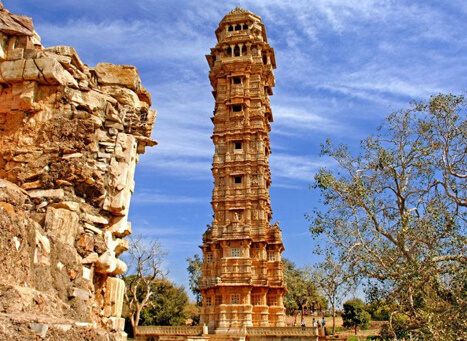
The fort was under siege thrice but has survived all through it and hence holds much historical importance and values. The Vijay Stambh has 9 storeys and each storey is decorated with the mythical stories of Hindu Gods and Goddesses. The beauty of this structure is more enhanced during the evenings when it is illuminated.
Padmini Palace Chittorgarh:-
One of the prominent tourist attractions in Chittorgarh, Padmini’s Palace narrates the story of the Cleopatra of India-Rani Padmini in its design. Also known as Rani Padmini’s Palace, it flaunts a three-Storeyed structure, which has its outer walls painted white and it overlooks a pleasant lotus pool. Surrounded by water, the architecture of the Palace is somehow influenced by the Jal Mahal of Jaipur.
One of the prominent tourist attractions in Chittorgarh, Padmini’s Palace narrates the story of the Cleopatra of India-Rani Padmini in its design. Also known as Rani Padmini’s Palace, it flaunts a three-Storeyed structure, which has its outer walls painted white and it overlooks a pleasant lotus pool. Surrounded by water, the architecture of the Palace is somehow influenced by the Jal Mahal of Jaipur.
History has it that Alauddin Khilji was smitten by the beauty of Rani Padmini and he used the surrounding water to catch the glimpses of her. His efforts to possess her resulted in the death of the Queen’s husband and her committing Jauhar. Today, the famous Padmini palace stands as a promising symbol of beauty, valor, honor and tragedy of the past of Chittor.
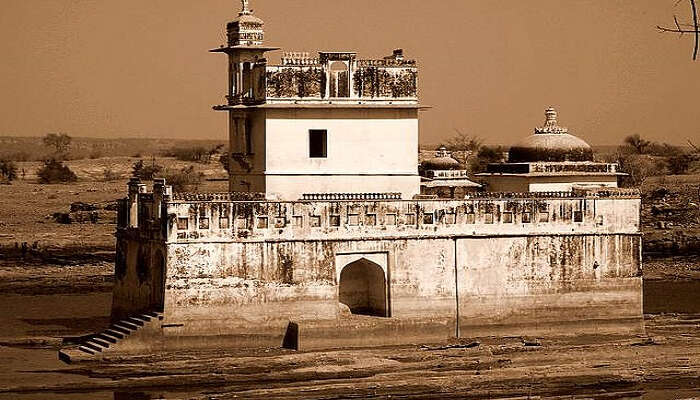
Government Museum :-
One of the most popular museums of Chittorgarh, Archaeological Museum is home to such valuable artifacts that are of immense historical significance. Placed at the eastern ending of Banbir-ki-Diwar, this museum boasts of an amazing collection of innumerable historical artifacts sourced from the Chittorgarh Fort and objects related to Hinduism as well as Buddhism that were found at the time of the excavation. One can also spot Buddhist stupas, under the trees. These stupas are placed quite close to Patta Tank and Jaimal Tank.
One of the most popular museums of Chittorgarh, Archaeological Museum is home to such valuable artifacts that are of immense historical significance. Placed at the eastern ending of Banbir-ki-Diwar, this museum boasts of an amazing collection of innumerable historical artifacts sourced from the Chittorgarh Fort and objects related to Hinduism as well as Buddhism that were found at the time of the excavation. One can also spot Buddhist stupas, under the trees. These stupas are placed quite close to Patta Tank and Jaimal Tank.
The collection at Archaeological Museum in Chittorgarh includes Stone Age objects, art and craft objects, coins, frescos, metallic objects, paintings, inscriptions, weapons, sculptures and terracotta figures etc. This museum was originally a fort, built by Maharaja Fateh Singh Ji during the 19th century. In the year 1968, it was transformed into a museum by the government.
Saturday, August 24, 2019
Jaisalmer Desert Festival – To Explore The Culture Of Rajasthan
12:27 AM
No comments
With a complete picture
of folk tunes, tinges as well as twines framed in the sandy dunes, the Desert Festival Jaisalmer shows the traditional culture of Rajasthan. In order to
reach the eyes of worldwide spectators, the festival would spray its colors, play
its tunes and also whir its heels from the hub of Thar Desert. As soon as you
came out from the winter wools and being stepped into the cuddly blossoming
flavor, the folk fusion from Jaisalmer will surely grasp the attention of
several travelers. Now, it’s your turn to explore yourself into the exciting
daylong extravaganza, which continues for about three days in the middle of
historical forts, ancient havelis, Jain temples, majestic palaces and
indigenous culture as well. Therefore, the Jaisalmer Desert Festival 2018 is
considered to be a perfect break out from the Modern age, which falls into the collage
of colorful art and old-fashioned grandeur from the diorama of Implausible
India.

The Jaisalmer desert festival
was found to be initiated with the intention to provide the tourists especially
those from exterior of India, a glance of the imperial state culture of
Rajasthan that has always been bewitched and fascinated them. The festival plans
to give an occasion to those visitors in order to add little more lifetime
souvenirs towards their visit in a limited time period of 3 days. Almost all
the events at Jaisalmer desert festival would get a large participation and
massive involvement that indulges in unprecedented revelry. During the
occasion, people are supposed to be exulted and elated too. Foreigners are
completely amused by getting a chance to become a part of rich Indian culture.
Looking out to capture
the global minds and also to extend its traditional colors, the Desert Festival
at Jaisalmer will undoubtedly exhibit the local elements & heritage. The
disharmony of Rajasthani art, folk dance and music are represented by the
professional artists. Fire and Gair
dancers remain the major attraction and in addition, the desert festival would
also tie up with many different cultural events including camel races, longest
moustache competition, turban tying and even Mr. Desert Contest. Moreover, a
desert safari to the swinging dunes of Sam will mark a great grand finale in
which one could able to applaud the clever
performance of several folk artists beneath the starlit dark sky.

Some interesting sights
at the Jaisalmer Desert Festival include entertaining puppet show, snake
charmers and also lively folk music performances. The folk music is influenced
by Sindh, the bordering region of Pakistan. Performers including Manganiyar
Folk Musicians will sing and dance regarding the triumphs & tribulations of
thieves over the ages. Additionally, the traditional acrobatic performances
have been done by the local nomadic gymnasts, who are referred as Nats or
Kalabaz. At the end, fireworks will explode all over the sky, which splashes
the landscape with further more bursts of light and color, thereby bringing the
ancient fort to life.
Organized by the
department of tourism in Rajasthan on a yearly basis in the month of February, the
Jaisalmer Desert Festival 2020 is going to hit the sandy dunes between 07 February 2020 and 09 February. It seems to be the appropriate time when
people can plan their Jaisalmer tour to explore the Thar Desert by getting
entailed in the festive mood.
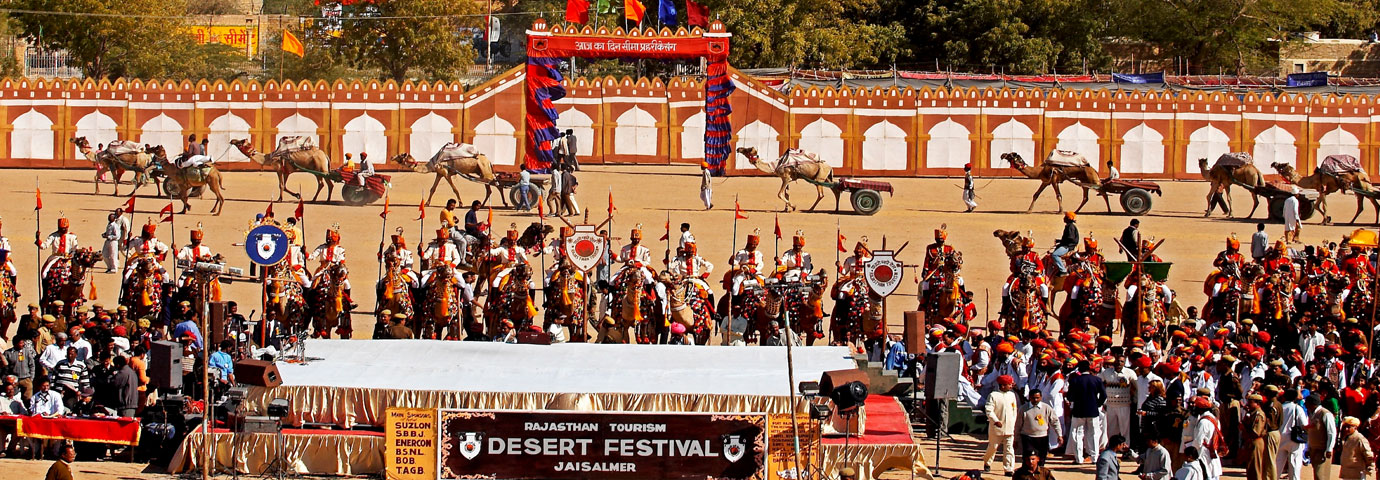
Jaisalmer is considered
to be a popular winter getaway found in India and also one amongst the exotic
honeymoon destinations. More than that, the city is sprinkled with traces of
many different sandstone heritages revealing a rich history of the place. It
will also unfold the indigenous Jain culture, which reflects from the engraved
pillars and wars of ancient Jain Temples sheltered within the Jaisalmer fort. A
unique style of Dilwara Paintings and architecture is exhibited by these
temples. Other major attractions of Jaisalmer include Laxminath Temples and
Royal Palace. However, the most demanded activity in Jaisalmer is assumed to be
desert safari.
If you visit India with
the aim to explore its mesmerizing deserts and sand dunes, don’t forget to get
pleasure from the desert safari to captivate some of the best moments of
fulfilled vacation. Most of the tour operators and travel agents in Rajasthan
arrange camel safaris, during which one came is given per person to offer you a
quick look of the desert.
Dune Bashing is best
referred as Desert Safari, which is an adventurer sport activity by which you
can able to explore the desert’s sand dunes. When it comes to India, the best
sand dune is assumed to be at Jaisalmer city of the Imperial state, Rajasthan.
Desert safari is commonly organized in two popular ways namely Indian style and
Dubai Style. In the Indian style, people will explore the desert on camel
together with an expert guide, whereas in the Dubai style, people are used off
road vehicle.
You can able to
discover the tranquility of Indian desert by camping in Rajasthan. Take a
luxury camp tour of Rajasthan to discover the actual essence of India within
its remote interiors and away from the chaos of commercialized towns &
cities. These camping expeditions will bring the indoor idyllic and outdoor
alive, albeit in style. The modern tents are up to the five start hotels and you
will be rest assured about the specialized service.

Jaisalmer will be
accessible by roads from many different cities found in Rajasthan without any
trouble. The city has hosted its very own railway station, which will connect
to the India’s farthest corners. Regular trains and buses fly from Udaipur,
Jaipur, New Delhi and Jodhpur to Jaisalmer, which will make a trouble free
getaway for the travelers. In addition, the tourism department of Rajasthan has
recently announced that the city of Jaisalmer will soon get its own airport for
the next tourist season.
Subscribe to:
Comments (Atom)

















